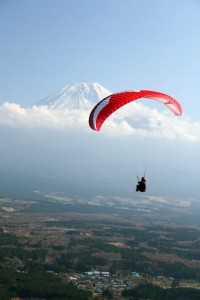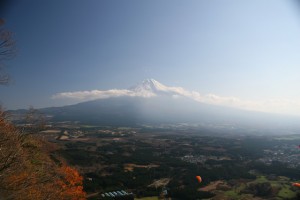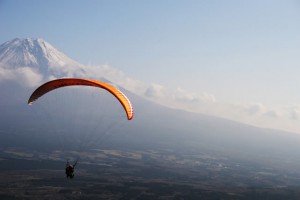Natural High -- Paragliding Mt. Fuji
- Details
This article originally published in the June 2011 issue of Adventure Insider Magazine.

When I was a very young child in England, there was a programme on television that granted wishes. It was run by a man called Jim, and children from around the country would write to him with their hopes and dreams and wait for him to sort them out: a kind of Santa Claus for experience, instead of presents. There was a little boy who got to drive James Bond’s car, and a child who got a part on Doctor Who; there was a young viewer who managed to temporarily become the third drummer in Adam and the Ants, and a class that got to eat lunch on a moving rollercoaster (or try). I wrote to Jim every single month for three years, and eventually my mum said she wasn’t giving me any more stamps unless she knew where they were going. “I`m writing to Jim,” I finally admitted. “What have you asked him for?” “To fly,” I said, showing her the letter. “Like Peter Pan. Or a bird.” There was a pause. “Umm,” mum said eventually, “Sweetheart, that’s quite a tall order.” “No it’s not,” I told her firmly, because I’d thought about it a great deal and it seemed perfectly feasible. “Peter Pan can do it. So I can as well.” “Well… Will you mind terribly if Jim attaches you to a string and swings you from the ceiling?” I glared at her. “Peter Pan doesn’t have a string and he’s not attached to the ceiling.” “What about if you go up in an aeroplane or a helicopter? Will that do?” “No.” “A hot air balloon?” “No.” “What about if I take you to the top of a tall building and then swing you around by your arms?” “Mum,” I sighed, rolling my eyes at her. “This is why you`re not Jim, isn’t it.” I waited and I waited, but Jim never wrote back. Because – my mum eventually told me, when I was a few years older – what I wanted was impossible. Not for small fictional children, obviously, but for real life people. Flying just wasn’t one of the privileges granted humans, she said, and the sooner I came to grips with that fact the happier I’d be on the ground. She was wrong, and I never adjusted to the disappointment of being land-based. Over the next twenty years, I tried it all. I tried the aeroplane and the helicopter, but it wasn’t like flying at all: it was like sitting in a moving room. I tried the hot air balloon, but that was like standing in a moving basket. I went up in a micro-light, and while it was definitely closer to the sky it was also noisy and jittery and felt like a machine. I got one of the local theatre companies to pull me around on a string, but – as I had suspected at the age of five – that was very much like being pulled around on a string. And my dad had to stop swinging me around, because eventually his arms started hurting. It was only on moving to Japan, however, that I finally got the wish that Jim hadn’t been able to grant me. It was only in Japan that I found paragliding.
In the world, there are dozens of perfect paragliding spots. You can paraglide over the Himalayas in Nepal and the Dolomites in Italy; you can hoist yourself over Table Mountain in Cape Town and Coronet Peak in New Zealand and the Swiss Alps; over the rainforest in Brazil and from fairytale castles in Europe. You can fly over the plains of Africa, or in India, or Korea, or Pakistan, or France; from Pakistan or Canada or the UK. Basically, if there`s a hill and a view you will find a nearby paragliding school. In Japan, there is nowhere better to paraglide than Mount Fuji. It’s not just because it’s the legend-riddled symbol of the nation, beloved by poets and artists for thousands of years, or the fact that it’s a near perfect volcano: almost perfectly symmetrical and at the right time of year topped with snow like the cream on a Japanese shaved ice “Kakigori”. It’s not just because it’s beautiful, or the biggest mountain in the country, or an internationally recognizable view. It’s not just because there are paragliding companies spread around the base of it so you can take your pick, or because the distinct four seasons in Japan mean that no flight is ever the same: blossoms in spring, red leaves in Autumn, a haze of white heat in summer and a blanket of snow in the winter. No: it’s also because if you fly in front of it, you don’t have to climb it too. That was my reasoning, anyway. Unfortunately, the infamously mysterious Fuji disappears completely at the slightest hint of fog or cloud, and so the rainy morning of my first ever flight was spent sitting in a room, with an inexplicable box of newborn puppies, waiting nervously to see if the sky would clear enough for us to leave the building. The paragliding company I flew with – WingKiss – is based on the Asigiri plateau, on the South East of Fuji in Fujinomiya, Shizuoka prefecture, and the building was packed full of semi-professionals and professionals waiting to get into the sky, with myself and my friend as the only two terrified first-timers. And, frankly, the confidence we’d had that morning had started to subside about four hours into sitting in a room, watching videos of people jumping off mountains with nothing but large nylon blankets harnessed to their bottoms. “Such a shame it’s bad weather,” we’d ended up muttering to the floor. “We might have to do it another day. Like tomorrow. Or next week. Or, you know, when we’re much older and closer to dying anyway.” The school – like most schools – offers courses that teach you how to fly on your own. There are any number of combination packages, ranging in experience and time and aptitude and cost, but we had taken none of them. For the first flight, we’d opted for the tandem jump where no experience or knowledge is required. We would simply be hoisted onto the front of a tandem glider with a professional flier and then left to hyperventilate our way down to the ground again with no responsibility whatsoever for our own safety. Easy. And the brief video training required was especially brief for me, because I don’t speak Japanese. So, I had simply watched with round eyes, nodding occasionally and hoping that I wasn’t being told anything I’d be expected to know at any stage in the future. Just after lunchtime the sun came out and the skies abruptly cleared – as skies in Shizuoka often do – and what was left of the nervous wrecks that used to be my friend and I were piled into a bus and driven to the top of the nearby mountain, Kono Azuma. At an altitude of 1,050 metres, this looked much bigger when I knew we were jumping off it. Before, it had looked quite little. Now, it looked like Everest. On the top of the mountain facing Fuji was a large, flat, blue tarpaulin area, slanted downwards towards a sheer drop: like an extreme sort of picnic blanket. When the bus stopped and shaky legs were swung out of the sliding doors, I held my hand up. “I’m sorry,” I told them, “but I’ve just realized that I can’t jump off a mountain. I’m game for flying, but I’m not game for jumping off mountains. They’re two very different things.” “Don`t worry,” they said, handing me a helmet. “You’re going with an English speaker. That way she can tell you if there’s a problem.” “Problem?” I squeaked, before being pushed gently over to a very tiny Japanese lady who grinned at how pale my face had gone. “What do you mean problem?” And then I looked at my tandem partner: the woman who would be controlling my life for the next thirty five minutes. She looked younger than me, and half my size. I`d been hoping for a six foot five mass of sheer fat and muscle to break my fall if I needed it. “Don’t worry,” she said, hooking the parachute on to us and slipping me into the holster. “It’ll be fun.” “Uh,” I replied, unconvinced, and suddenly I wasn’t so sure about being Peter Pan after all. It was suddenly too real, and too clear that there was absolutely nothing separating me from the air or the ground: nothing but a few bits of material under my bottom resembling a big crotchless rope nappy and a large bit of material over my head that looked like hi-tech bedding. No floor, no metal, no seat. No large basket to walk around in. No in-flight films or speaker systems to tell me about turbulence. No ceiling, and definitely no string. Just me, a stranger, a few bits of material, a very big mountain and a whole lot of sky. I looked anxiously at the cliff edge. “Now,” she said, “when I say run, run. And when I say lift, lift.” She started walking forwards. “Now?” I squeaked. I had thought we’d be given a few hours of motivational speeches first. “You want me to run at nothing?” I clarified. “Yes.” “I don’t think I can,” I explained. “I can’t really run when there’s earth on the other end of it.” “Sure you can,” she said from behind me. “Now run!” And I ran. I ran the only way you can run towards the edge of a mountain edge when every single natural instinct in your body is telling you not to: muttering swear words under my breath. “And lift!” she shouted from behind me. I swore again and lifted my legs. And the ground abruptly disappeared. Suddenly, it was silent. The only sound was me – no longer swearing but taking large, shuddering breaths as I watched my feet float 1,000 metres above the ground – and the wind around us and on top of us and underneath us. We had been abruptly suspended in the air, the way eagles hang looking for prey: not falling, as every part of my unconscious brain expected to be, but flying. The thin harness underneath our bottoms and the sheet above our heads seemed to become part of us and as natural as wings: to almost disappear completely. And as the parachute swayed gently to the left and the right, my breathing grew steadier and deeper and the sky grew strangely bigger.
Around us, the farming lands of Asigiri stretched: green and brown and patchworked and tiny. Below us, a dark green pine forest lined the mountain. To the side, my friend waved from his parachute: presumably no longer swearing under his breath either. And in front, looming perfect and clear and huge, was Mount Fuji. With its snow cap hanging in the air above the blueish cone like some kind of lid you could pop off. The view of a million postcards, and a million calendars, and a million paintings. And much, much better than any of them. I took another shuddering breath. After nearly thirty years, I was finally flying. And it was exactly the way I thought it would be. “Like it?” my tandem partner said after ten minutes of watching the sky open up and my feet dangle into nothing. “No,” I said, still trembling. “I love it.” “Want to spin?” she asked. “Umm,” I said, and suddenly the sky disappeared. And we span: in spirals that looped us like an invisible rollercoaster while I shouted until my throat hurt. “Okay!” I finally managed to yell. “Enough spinning!” She laughed. “That’s my favourite bit.” Thirty-five minutes in the air, and it was the longest thirty-five minutes of my life and also the shortest. Every minute felt different, and every minute I noticed something else. Birds were flying below us, and planes were above us: for the first time, I was airborne and squidged in between. Now that the sky had cleared paragliders were appearing by the minute, and the sky was filling with tiny puffs of neon sheets, like bright pollen. The air smelt of the pine trees and the grasslands underneath us. And never before had the adrenalin of an extreme sport combined with such a sensation of peace: the heart-pounding, hand trembling, mind sharpening excitement of knowing you’re hanging 1,000 feet above the ground mixed with the dreamy, calm, surreal experience of floating. Never before had something so unnatural felt so organic. Never had something so dangerous seemed so safe. And while it wasn’t flying the way Superman flew – zooming through the air – it was flying the way Peter Pan flew when he hung in the air and waited for Wendy to catch up. Without a motor, and without metal. Just me and the sky. And that was what I had wanted as a five-year-old. Not to zoom, but to be suspended As we reluctantly descended, I asked how long we could have stayed up there if I wasn’t paying for a thirty-five minute session. “As long as the wind lasts,” my tandem partner said. “All day, sometimes. I usually bring a sandwich.” Then she laughed. “Now,” she said as the landing field got closer, “when I say run, run. And keep your legs bent.”
“There’s a whole lot of running involved in flying, isn’t there,” I grumbled, and prepared my legs to run into nothing again. And as we watched the ground approach, I realized that I wanted to cry. It had taken me so long to get into the air, and it seemed so unfair that I had to come back down again so soon. I wanted to stay up there all day too. “Now,” she told me as the ground approached, “run.” And I ran until the ground caught up with me, at which point I promptly fell over. All the grace and peace I had found in the sky immediately abandoned me, because I was land-based all over again. And I really didn’t want to be. “Was everything okay?” my friend asked as we de-parachuted and de-helmeted and I did a few little jumps of happiness; partly to celebrate, and partly to get back in the air. “Amazing,” I told him. “I saw you spinning and thought something had gone wrong.” “Nope. Apparently she just likes doing it.” “You know,” one of the other parachuters told me: “of all of us, you won the jackpot. You know that girl you just came down with? Your tandem instructor?” “Yeah?” I looked at the tiny girl behind me with flushed cheeks and the big grin: the one who had controlled my life – and whether I would continue having one – for thirty-five minutes. The one who wasn’t a six-foot-five lump of muscle and fat, and hadn’t had to be. “She’s a world champion paraglider, just back from the Olympics in Italy. She helps out here for fun. You just had the experience of a lifetime.” I looked at her again, and then I thought about it for a few seconds. “I know,” I said eventually. Because I already did. As we drove away from the site, I looked back at the sky where dozens of tiny paragliders were hanging: dots of colour against the blue. They didn’t look like planes, I realized, or helicopters, or micro-lights. They didn’t look like they were on strings, or hot air-balloons, or any man-made type of flying. They looked like birds of prey, hanging in the sky and sitting in the wind. And they looked exactly like Peter Pan and a hundred Lost Boys, just after they had flown out of the window. The letters I wrote may not have gone to the right place, but they worked in the end. Twenty years later I gotten to fly, just as I was sure I could. And eventually I’ll take enough flights that I’m allowed to go on my own. Because that’s how Peter Pan flew too: all by himself. Most of us want to fly as children, and sometimes as we get older we begin to believe it’s impossible. As Wendy asked when she was little, “Why can’t you fly, mother?” And as her mother answered: “Because I am grown-up, dearest. When people grow up they forget the way.” There aren’t many wishes we make as children that we can grant ourselves as adults, and there are too many dreams we put away unfulfilled. With paragliding, even the most land-tied adults can remember how to fly all over again.
Holly Miranda Smale is a writer, teacher and ex-PR Girl from a place in England that you won’t have heard of unless you read the back of packets of Shredded Wheat, and has never been referred to as “the love child of Anne of Green Gables and Adrian Mole” in her life.
Over the past twenty nine years, Holly has wanted to be: a ballerina, a starving poet, an airplane pilot, Claire Danes, a scientist, a spaceman, a journalist and an internationally best-selling author. She has been: a courgette packer, a dinner lady, a cleaner, a (very bad) fashion model, a PR executive, a receptionist, and a door-to-door salesman. Holly has improbably high hopes that one day something on these two lists will match.
However, until or unless this happens, she fully intends to continue “gadding around the world with no shoes on” and can only hope that when further gadding becomes impossible her younger sister will convert the shed so that she can wrap herself in a blanket and live in it during the winter months.
She lives at www.thewritegirl.co.uk, and is currently based in Japan.

When I was a very young child in England, there was a programme on television that granted wishes. It was run by a man called Jim, and children from around the country would write to him with their hopes and dreams and wait for him to sort them out: a kind of Santa Claus for experience, instead of presents. There was a little boy who got to drive James Bond’s car, and a child who got a part on Doctor Who; there was a young viewer who managed to temporarily become the third drummer in Adam and the Ants, and a class that got to eat lunch on a moving rollercoaster (or try). I wrote to Jim every single month for three years, and eventually my mum said she wasn’t giving me any more stamps unless she knew where they were going. “I`m writing to Jim,” I finally admitted. “What have you asked him for?” “To fly,” I said, showing her the letter. “Like Peter Pan. Or a bird.” There was a pause. “Umm,” mum said eventually, “Sweetheart, that’s quite a tall order.” “No it’s not,” I told her firmly, because I’d thought about it a great deal and it seemed perfectly feasible. “Peter Pan can do it. So I can as well.” “Well… Will you mind terribly if Jim attaches you to a string and swings you from the ceiling?” I glared at her. “Peter Pan doesn’t have a string and he’s not attached to the ceiling.” “What about if you go up in an aeroplane or a helicopter? Will that do?” “No.” “A hot air balloon?” “No.” “What about if I take you to the top of a tall building and then swing you around by your arms?” “Mum,” I sighed, rolling my eyes at her. “This is why you`re not Jim, isn’t it.” I waited and I waited, but Jim never wrote back. Because – my mum eventually told me, when I was a few years older – what I wanted was impossible. Not for small fictional children, obviously, but for real life people. Flying just wasn’t one of the privileges granted humans, she said, and the sooner I came to grips with that fact the happier I’d be on the ground. She was wrong, and I never adjusted to the disappointment of being land-based. Over the next twenty years, I tried it all. I tried the aeroplane and the helicopter, but it wasn’t like flying at all: it was like sitting in a moving room. I tried the hot air balloon, but that was like standing in a moving basket. I went up in a micro-light, and while it was definitely closer to the sky it was also noisy and jittery and felt like a machine. I got one of the local theatre companies to pull me around on a string, but – as I had suspected at the age of five – that was very much like being pulled around on a string. And my dad had to stop swinging me around, because eventually his arms started hurting. It was only on moving to Japan, however, that I finally got the wish that Jim hadn’t been able to grant me. It was only in Japan that I found paragliding.

In the world, there are dozens of perfect paragliding spots. You can paraglide over the Himalayas in Nepal and the Dolomites in Italy; you can hoist yourself over Table Mountain in Cape Town and Coronet Peak in New Zealand and the Swiss Alps; over the rainforest in Brazil and from fairytale castles in Europe. You can fly over the plains of Africa, or in India, or Korea, or Pakistan, or France; from Pakistan or Canada or the UK. Basically, if there`s a hill and a view you will find a nearby paragliding school. In Japan, there is nowhere better to paraglide than Mount Fuji. It’s not just because it’s the legend-riddled symbol of the nation, beloved by poets and artists for thousands of years, or the fact that it’s a near perfect volcano: almost perfectly symmetrical and at the right time of year topped with snow like the cream on a Japanese shaved ice “Kakigori”. It’s not just because it’s beautiful, or the biggest mountain in the country, or an internationally recognizable view. It’s not just because there are paragliding companies spread around the base of it so you can take your pick, or because the distinct four seasons in Japan mean that no flight is ever the same: blossoms in spring, red leaves in Autumn, a haze of white heat in summer and a blanket of snow in the winter. No: it’s also because if you fly in front of it, you don’t have to climb it too. That was my reasoning, anyway. Unfortunately, the infamously mysterious Fuji disappears completely at the slightest hint of fog or cloud, and so the rainy morning of my first ever flight was spent sitting in a room, with an inexplicable box of newborn puppies, waiting nervously to see if the sky would clear enough for us to leave the building. The paragliding company I flew with – WingKiss – is based on the Asigiri plateau, on the South East of Fuji in Fujinomiya, Shizuoka prefecture, and the building was packed full of semi-professionals and professionals waiting to get into the sky, with myself and my friend as the only two terrified first-timers. And, frankly, the confidence we’d had that morning had started to subside about four hours into sitting in a room, watching videos of people jumping off mountains with nothing but large nylon blankets harnessed to their bottoms. “Such a shame it’s bad weather,” we’d ended up muttering to the floor. “We might have to do it another day. Like tomorrow. Or next week. Or, you know, when we’re much older and closer to dying anyway.” The school – like most schools – offers courses that teach you how to fly on your own. There are any number of combination packages, ranging in experience and time and aptitude and cost, but we had taken none of them. For the first flight, we’d opted for the tandem jump where no experience or knowledge is required. We would simply be hoisted onto the front of a tandem glider with a professional flier and then left to hyperventilate our way down to the ground again with no responsibility whatsoever for our own safety. Easy. And the brief video training required was especially brief for me, because I don’t speak Japanese. So, I had simply watched with round eyes, nodding occasionally and hoping that I wasn’t being told anything I’d be expected to know at any stage in the future. Just after lunchtime the sun came out and the skies abruptly cleared – as skies in Shizuoka often do – and what was left of the nervous wrecks that used to be my friend and I were piled into a bus and driven to the top of the nearby mountain, Kono Azuma. At an altitude of 1,050 metres, this looked much bigger when I knew we were jumping off it. Before, it had looked quite little. Now, it looked like Everest. On the top of the mountain facing Fuji was a large, flat, blue tarpaulin area, slanted downwards towards a sheer drop: like an extreme sort of picnic blanket. When the bus stopped and shaky legs were swung out of the sliding doors, I held my hand up. “I’m sorry,” I told them, “but I’ve just realized that I can’t jump off a mountain. I’m game for flying, but I’m not game for jumping off mountains. They’re two very different things.” “Don`t worry,” they said, handing me a helmet. “You’re going with an English speaker. That way she can tell you if there’s a problem.” “Problem?” I squeaked, before being pushed gently over to a very tiny Japanese lady who grinned at how pale my face had gone. “What do you mean problem?” And then I looked at my tandem partner: the woman who would be controlling my life for the next thirty five minutes. She looked younger than me, and half my size. I`d been hoping for a six foot five mass of sheer fat and muscle to break my fall if I needed it. “Don’t worry,” she said, hooking the parachute on to us and slipping me into the holster. “It’ll be fun.” “Uh,” I replied, unconvinced, and suddenly I wasn’t so sure about being Peter Pan after all. It was suddenly too real, and too clear that there was absolutely nothing separating me from the air or the ground: nothing but a few bits of material under my bottom resembling a big crotchless rope nappy and a large bit of material over my head that looked like hi-tech bedding. No floor, no metal, no seat. No large basket to walk around in. No in-flight films or speaker systems to tell me about turbulence. No ceiling, and definitely no string. Just me, a stranger, a few bits of material, a very big mountain and a whole lot of sky. I looked anxiously at the cliff edge. “Now,” she said, “when I say run, run. And when I say lift, lift.” She started walking forwards. “Now?” I squeaked. I had thought we’d be given a few hours of motivational speeches first. “You want me to run at nothing?” I clarified. “Yes.” “I don’t think I can,” I explained. “I can’t really run when there’s earth on the other end of it.” “Sure you can,” she said from behind me. “Now run!” And I ran. I ran the only way you can run towards the edge of a mountain edge when every single natural instinct in your body is telling you not to: muttering swear words under my breath. “And lift!” she shouted from behind me. I swore again and lifted my legs. And the ground abruptly disappeared. Suddenly, it was silent. The only sound was me – no longer swearing but taking large, shuddering breaths as I watched my feet float 1,000 metres above the ground – and the wind around us and on top of us and underneath us. We had been abruptly suspended in the air, the way eagles hang looking for prey: not falling, as every part of my unconscious brain expected to be, but flying. The thin harness underneath our bottoms and the sheet above our heads seemed to become part of us and as natural as wings: to almost disappear completely. And as the parachute swayed gently to the left and the right, my breathing grew steadier and deeper and the sky grew strangely bigger.

Around us, the farming lands of Asigiri stretched: green and brown and patchworked and tiny. Below us, a dark green pine forest lined the mountain. To the side, my friend waved from his parachute: presumably no longer swearing under his breath either. And in front, looming perfect and clear and huge, was Mount Fuji. With its snow cap hanging in the air above the blueish cone like some kind of lid you could pop off. The view of a million postcards, and a million calendars, and a million paintings. And much, much better than any of them. I took another shuddering breath. After nearly thirty years, I was finally flying. And it was exactly the way I thought it would be. “Like it?” my tandem partner said after ten minutes of watching the sky open up and my feet dangle into nothing. “No,” I said, still trembling. “I love it.” “Want to spin?” she asked. “Umm,” I said, and suddenly the sky disappeared. And we span: in spirals that looped us like an invisible rollercoaster while I shouted until my throat hurt. “Okay!” I finally managed to yell. “Enough spinning!” She laughed. “That’s my favourite bit.” Thirty-five minutes in the air, and it was the longest thirty-five minutes of my life and also the shortest. Every minute felt different, and every minute I noticed something else. Birds were flying below us, and planes were above us: for the first time, I was airborne and squidged in between. Now that the sky had cleared paragliders were appearing by the minute, and the sky was filling with tiny puffs of neon sheets, like bright pollen. The air smelt of the pine trees and the grasslands underneath us. And never before had the adrenalin of an extreme sport combined with such a sensation of peace: the heart-pounding, hand trembling, mind sharpening excitement of knowing you’re hanging 1,000 feet above the ground mixed with the dreamy, calm, surreal experience of floating. Never before had something so unnatural felt so organic. Never had something so dangerous seemed so safe. And while it wasn’t flying the way Superman flew – zooming through the air – it was flying the way Peter Pan flew when he hung in the air and waited for Wendy to catch up. Without a motor, and without metal. Just me and the sky. And that was what I had wanted as a five-year-old. Not to zoom, but to be suspended As we reluctantly descended, I asked how long we could have stayed up there if I wasn’t paying for a thirty-five minute session. “As long as the wind lasts,” my tandem partner said. “All day, sometimes. I usually bring a sandwich.” Then she laughed. “Now,” she said as the landing field got closer, “when I say run, run. And keep your legs bent.”

“There’s a whole lot of running involved in flying, isn’t there,” I grumbled, and prepared my legs to run into nothing again. And as we watched the ground approach, I realized that I wanted to cry. It had taken me so long to get into the air, and it seemed so unfair that I had to come back down again so soon. I wanted to stay up there all day too. “Now,” she told me as the ground approached, “run.” And I ran until the ground caught up with me, at which point I promptly fell over. All the grace and peace I had found in the sky immediately abandoned me, because I was land-based all over again. And I really didn’t want to be. “Was everything okay?” my friend asked as we de-parachuted and de-helmeted and I did a few little jumps of happiness; partly to celebrate, and partly to get back in the air. “Amazing,” I told him. “I saw you spinning and thought something had gone wrong.” “Nope. Apparently she just likes doing it.” “You know,” one of the other parachuters told me: “of all of us, you won the jackpot. You know that girl you just came down with? Your tandem instructor?” “Yeah?” I looked at the tiny girl behind me with flushed cheeks and the big grin: the one who had controlled my life – and whether I would continue having one – for thirty-five minutes. The one who wasn’t a six-foot-five lump of muscle and fat, and hadn’t had to be. “She’s a world champion paraglider, just back from the Olympics in Italy. She helps out here for fun. You just had the experience of a lifetime.” I looked at her again, and then I thought about it for a few seconds. “I know,” I said eventually. Because I already did. As we drove away from the site, I looked back at the sky where dozens of tiny paragliders were hanging: dots of colour against the blue. They didn’t look like planes, I realized, or helicopters, or micro-lights. They didn’t look like they were on strings, or hot air-balloons, or any man-made type of flying. They looked like birds of prey, hanging in the sky and sitting in the wind. And they looked exactly like Peter Pan and a hundred Lost Boys, just after they had flown out of the window. The letters I wrote may not have gone to the right place, but they worked in the end. Twenty years later I gotten to fly, just as I was sure I could. And eventually I’ll take enough flights that I’m allowed to go on my own. Because that’s how Peter Pan flew too: all by himself. Most of us want to fly as children, and sometimes as we get older we begin to believe it’s impossible. As Wendy asked when she was little, “Why can’t you fly, mother?” And as her mother answered: “Because I am grown-up, dearest. When people grow up they forget the way.” There aren’t many wishes we make as children that we can grant ourselves as adults, and there are too many dreams we put away unfulfilled. With paragliding, even the most land-tied adults can remember how to fly all over again.


